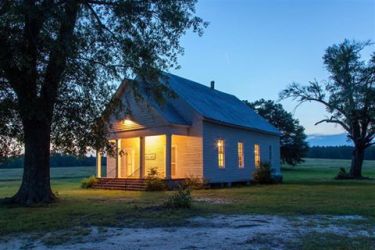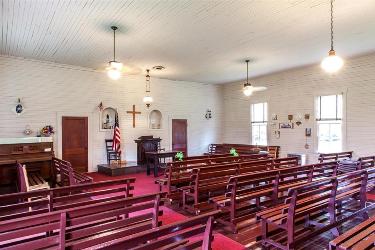

This online news website is owned and operated by Becky Watts. If you enjoy reading Pike County Times, consider buying an advertisement for your business or sending a donation to support the only free online newspaper in Pike County. Donations can be sent to: The Pike County Times, PO Box 843, Zebulon, Georgia 30295. Click here to donate through PayPal. Thanks for supporting Pike County's only free online newspaper!

Photograph by Mark Caceres of Smyrna.

Photographs by Mark Caceres of Smyrna.
ATLANTA – The New Hebron Baptist Church has been listed in the National Register of Historic Places. The property is located at 570 New Hebron Church Road in Concord (Pike County). The nomination was sponsored by the property owner, and the nomination materials were prepared by Vicar Dwain W. Penn, of the church.
New Hebron Baptist Church was chartered in 1907 with 30 members, and began meeting in a school building approximately two miles west of Concord, in a community known as “Piney Woods.” After meeting in the school building for nine months, the new congregation decided to erect a church building of their own. By August 1908, New Hebron Baptist Church had been constructed adjacent to the school building on land donated by early area settler and prominent Concord merchant, John Franklin Madden. By 1929, the congregation had increased to 99 members. Membership waned by the mid-20th century, however, and the church’s final two members passed away in the 1990s. Nonetheless, the church has continued to offer monthly services and serve as a location for classes, Bible conferences, and special events.
New Hebron Baptist Church was listed in the National Register of Historic Places as an outstanding and remarkably intact example of an early 20th century church building. The church is a representative example of the type of simple church built for rural congregations in Georgia during the 19th and early 20th centuries. The church retains integrity of design and materials, with exterior character-defining features including the discernable gable-front form, wood-frame construction lacking ornamentation, and paired entry doors. The interior of the church was originally a single room, but was partitioned in 1947 to create Sunday school classrooms in the front third of the sanctuary. Beyond the partitioning of classrooms, the church’s interior is otherwise unchanged, with original features including its large open sanctuary space, original painted bead board walls and ceilings, pine floor boards, and slatted wooden pews. In the sanctuary, the pews face a modest wood pulpit, centered on the north wall. The former classroom area is comprised of three rooms, today serving as a bathroom, storage room, and fellowship hall. Two arched alcoves are centered in the north wall between two door openings that access the former classroom space. The church’s sustained rural surroundings also contribute to the property’s integrity of setting, feeling, and association.
The National Register of Historic Places is our country's official list of historic buildings, structures, sites, objects, and districts worthy of preservation. The National Register provides formal recognition of a property's architectural, historical, or archaeological significance. It also identifies historic properties for planning purposes, and insures that these properties will be considered in the planning of state or federally assisted projects. National Register listing encourages preservation of historic properties through public awareness, federal and state tax incentives, and grants. Listing in the National Register does not place obligations or restrictions on the use, treatment, transfer, or disposition of private property.
The Historic Preservation Division (HPD) of the Georgia Department of Natural Resources serves as Georgia’s state historic preservation office. Its mission is to promote the preservation and use of historic places for a better Georgia. HPD’s programs include archaeology protection and education, environmental review, grants, historic resource surveys, tax incentives, the National Register of Historic Places, community planning and technical assistance.
The mission of the Department of Natural Resources is to sustain, enhance, protect and conserve Georgia’s natural, historic and cultural resources for present and future generations, while recognizing the importance of promoting the development of commerce and industry that utilize sound environmental practices.